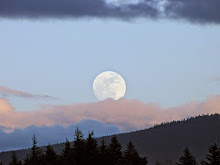Thanks to Max for the heads up on this.
Update: Max reminds me of how different a total eclipse is from a partial eclipse (even with 90+% coverage).
Here's Annie Dillard:
"I had seen a partial eclipse in 1970. A partial eclipse is very interesting. It bears almost no relation to a total eclipse. Seeing a partial eclipse bears the same relation to seeing a total eclipse as kissing a man does to marrying him, or as flying in an airplane has to falling out of an airplane. Although the one experience precedes the other, it in no way prepares you for it. During a partial eclipse the sky does not darken--not even when 94 percent of the sun is hidden."
("Total Eclipse" in Teaching a Stone to Talk)



4 comments:
Cool pics! The sx30 shot looks just like the view I caught from our front yard at about that time. I looked out there occasionally, but mostly followed it in a window on the spacecam livestream: http://events.slooh.com/
When we had the total eclipse back around 1979, I drove up the Gorge to get away from the clouds. Found a place in the semi-desert, set up a 35 mm camera, and waited. I wasn't ready for what happened.
Totality had started by the time it got to the Portland area, and all of a sudden, a wall of black came shooting up the Gorge out of the west, striking with an almost physical impact. I'd never seen anything move that fast; forgot to take a photo. A graphic illustration of how fast our planet is actually spinning....
I did get a photo of the "diamond ring", though.
Max, you remind me of Annie Dillard's description of the 1979 eclipse in "Total Eclipse" in _Teaching a Stone to Talk_:
"The second before the sun went out we saw a wall of dark shadow come speeding at us. We no sooner saw it than it was upon us, like thunder. It roared up the valley. It slammed our hill and knocked us out. It was the monstrous swift shadow cone of the moon. I have since read that this wave of shadow moves 1,800 miles an hour. Language can give no sense of this kind of speed--1,800 miles an hour. It was 195 miles wide. No end was in sight--you saw only the edge. It rolled at you across the land at 1,800 miles an hour, hauling darkness like plague behind it. Seeing it, and knowing it was coming straight for you, was like feeling a slug of anesthetic shoot up your arm. If you think very fast, you may have time to think, 'Soon it will hit my brain.' You can feel the deadness race up your arm; you can feel the appalling, inhuman speed of your own blood. We saw the wall of shadow coming, and screamed before it hit."
Very cool, TD - but she's dead on. I thought it might have had something to do with being in the Gorge, but her experience is almost identical to mine. Seeing it flash up at unbelievable speed, a wall of total darkness - I couldn't think to press the trigger in my hand. I knew then how the ancients must have felt; even though I knew what was happening, the impact is overwhelming.
At least I know it wasn't just my weird take on it; I'll have to look at her book. Thanks for the heads-up!
Max, it is amazing how your account and Dillard's match. We get too used to the wonders around us, but there are things that still hold their riveting power (the ocean and lightning storms do that for me) and some things that do really produce what is a fearful awe.
Events like those give just a taste of what biblical writers felt when they talked of falling down as dead before angelic and divine beings. And as you say, despite knowledge of what is happening, we still have the visceral reaction that the ancients had (even those who knew a good deal about science).
Thank you for describing your experience and feelings.
Post a Comment